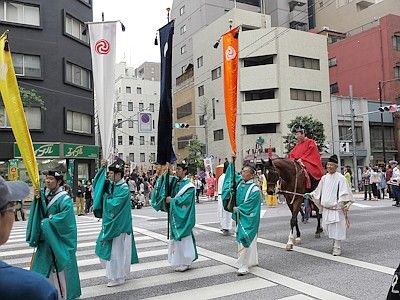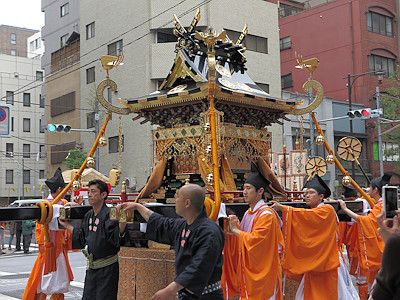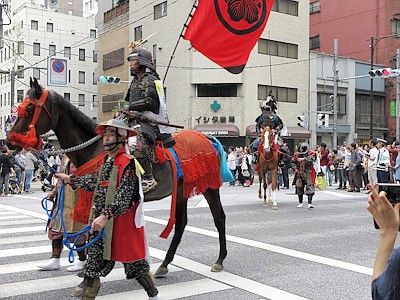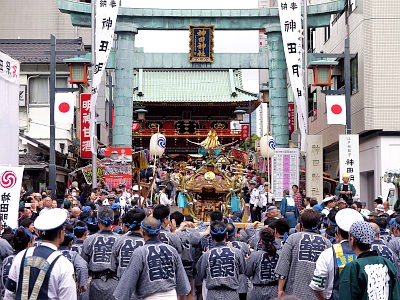Kanda Myojin Shrine
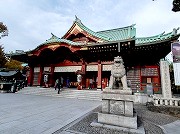 Kanda Myojin (神田明神), formally Kanda Jinja (神田神社), is a Shinto shrine located in central Tokyo. This shrine was founded in 730, and when the Tokugawa Shogunate opened its government here in Edo (present-day Tokyo) in the 17th century, it became the overall guardian of the town of Edo. For this reason, though it is not so large, it's a prominent, popular shrine.
Kanda Myojin (神田明神), formally Kanda Jinja (神田神社), is a Shinto shrine located in central Tokyo. This shrine was founded in 730, and when the Tokugawa Shogunate opened its government here in Edo (present-day Tokyo) in the 17th century, it became the overall guardian of the town of Edo. For this reason, though it is not so large, it's a prominent, popular shrine.
Deities enshrined here are Onamuchi-no-mikoto, Sukunahikona-no-mikoto, and Taira no Masakado. First two gods are those who developed this country together in the age of the gods. The last one, Taira no Masakado, is a historical war lord who rebelled against the Imperial Court in Kyoto trying to establish his own country in the Kanto region (which includes modern-day Tokyo) but was eventually killed by government forces in 940.
It's a 5-minute walk from Ochanomizu Station of the JR Chuo Line or the Tokyo Metro Marunouchi Line, and is across the street from Yushima Seido.
Architecture of Kanda Myojin
After WWII, since many wooden buildings were burned down during the war, it has become pretty common for Shinto shrines in large cities to rebuild their complexes in concrete in order to resist fire (and earthquakes), but before the war it was pretty uncommon because Shintoism is a conservative religion and therefore hesitated to accept this new material for its architecture at first. But some shrines did accept, because Tokyo experienced a huge earthquake followed by a massive fire in 1923, and many wooden (and brick or stone) constructions were destroyed or severely damaged on this occasion.
Kanda Myojin's present main architecture, completed in 1934, is one of these early examples, though it is painted with traditional Japanese lacquer instead of Western paints usually used for concrete buildings. (This is about the very central buildings only. Most of other concrete buildings in the shrine were constructed after the war, and the Zuishinmon gate is also a post-war reconstruction made of wood.)
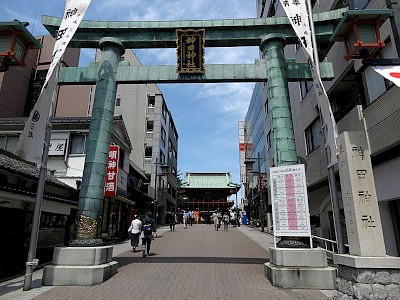
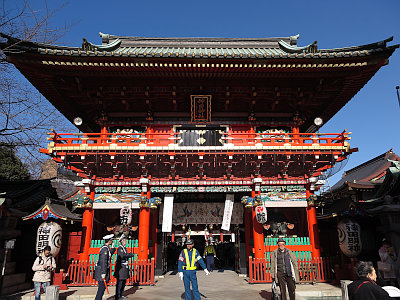
Zuishinmon is a gate which houses a pair of guardian divinities Zuishin on the front side.
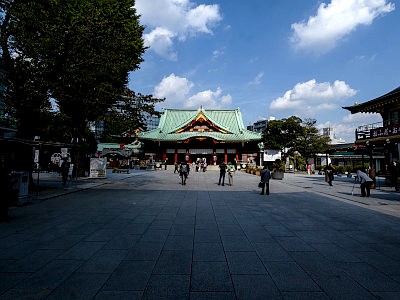

Haiden is where you offer prayers to the shrine divinities enshrined in Honden in the recess.
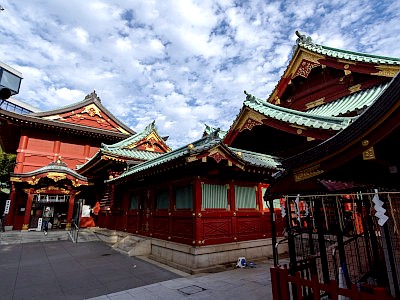
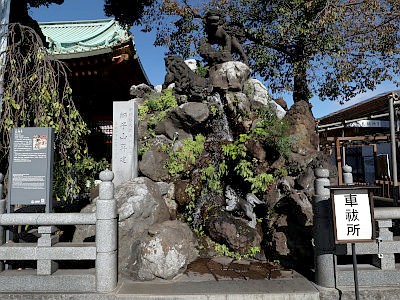
This monument is based on a legend that lion parents push their cubs over the cliff into a steep valley and only those cubs that were able to climb back to where the parents are by themselves are allowed to live.
Hatsumoude
Many people visit Shinto shrines on early January to pay their first prayers, especially during the first three days of the year (初詣). Kanda Shrine is no exception, and since it's a major shrine, it attracts pretty many people. Below are the photos taken at around 5:30am on Jan 1.
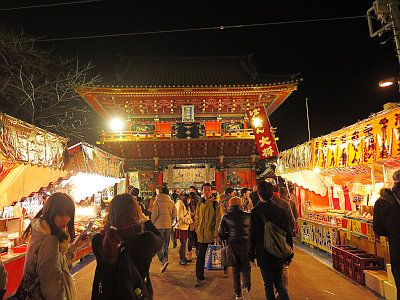
Daikoku-sai
At a weekend in mid-January, there's a festival called Daikoku-sai (だいこく祭), which is composed of Kanchu-misogi, Shijoryu Hocho-gishiki and Kigangushi-jojusai.
In the Saturday morning, Kanchu-misogi, a purification ritual by washing the body in a small pool with a large ice pillar, is conducted.
At Sunday noon, Shijoryu Hocho-gishiki, a hocho knife ritual which is said to have originated in the 9th century, is presented.There's also a small ritual called Kigangushi-jojusai in the afternoon of that day.
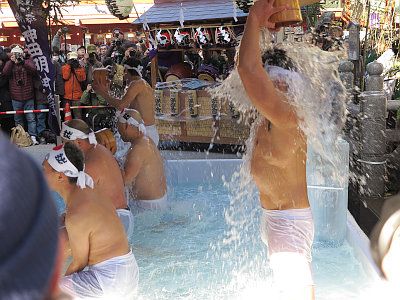
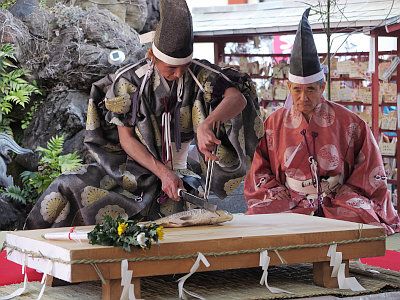
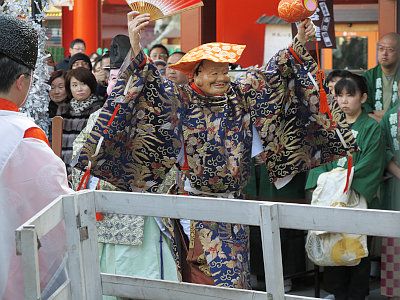
Setsubun-sai
On Setsubun Day (Feb), many Shinto shrines and large Buddhist temples hold bean-throwing events to drive away evil spirits called Setsubun-sai (節分祭). At Kanda Shrine, it starts with a parade from 2pm, which ends at around 2:20pm. After that, there will be rituals taking place in the main building but ordinary people cannot see what's going on there. At 2:40, two priests in dressed in ancient formal warrior suits pretend to shoot arrows to drive off evil spirits. After that, a bean-throwing event takes place, chanting "go away, evil spirits, come in, luck".
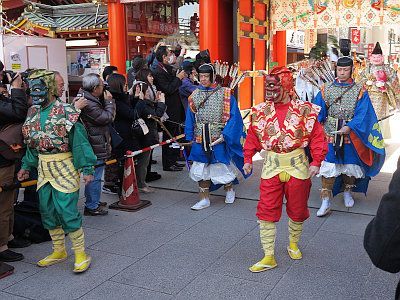
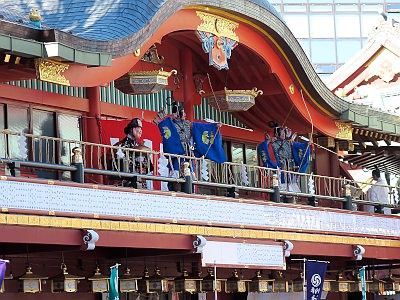
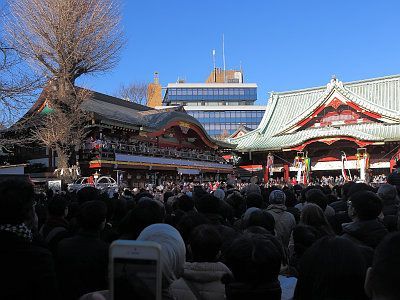
Kanda Matsuri
Kanda Matsuri (神田祭), one of the most notable traditional festivals in Tokyo, is the annual grand festival of this shrine.
Its main events are held on the weekend closest to May 15, but this festival is fully conducted only in odd-numbered years.
In odd-numbered years, on Saturday three shrine-owned mikoshi (portable shrines), each carrying one of the three deities, start parading from the shrine in the morning and return to the shrine in the evening. On the following day, more than 200 mikoshi owned by local communities parade to the shrine from surrounding areas all day. These parades in the weekend are not held in even numbered years. For details about this festival, see the article on Kanda Matsuri.



